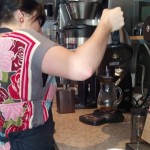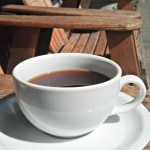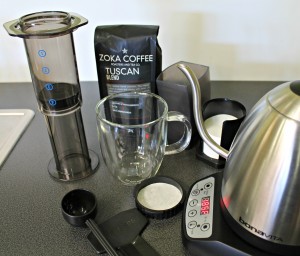

Coffee For Congress: Coffee on The Hill Event 10/22/13
During the recent National Coffee Association Summit in Philadelphia, I discovered the NCA planned a one-day coffee event for Congress to help bring attention to coffee and coffee issues. The NCA’s Donna Pacheco seemed to have everything planned, but when I volunteered she graciously suggested I might be able to discuss coffee with the Congressional staff who attend.
The issues in coffee are pretty straightforward. I think most everyone shares them. NCA CEO Robert F. Nelson would probably say the coffee industry wants to be more or less self-regulating, like the cosmetics industry. Doesn’t it make sense that the folks who know the most about how to proceed are those closest to the situation? How much labeling do we really need on one of the world’s oldest products? Think of the apple (fruit, not iPod). Do you really need or want nutrition information stamped on your apple? Is it worth the cost? And coffee, with things like caffeine content varying widely depending upon variety and roast, would impose an entirely new cost on the roasters, which of course hurts the smallest guys most. Does a centuries proven safe beverage like coffee really required to be treated like a laboratory-fabricated energy drink?
Also, how about some immigration reform ala coffee? Isn’t coffee that’s brokered, stored, roasted and brewed in the US entitled to be called Made in USA? These are issues the industry wanted to get across. I decided my role was best served by listening and observing first. Second, if asked I would talk brewing and consumers.
I did wish to stump for more relationship building from seed to cup. I can’t think of a more potentially useful group to help with this than the State Department, who is charged to look for ways to improve communications with our neighbors, many of them coffee producing nations. CoffeeCon’s mission is to build a kind of “farmstand rapport” between U.S. consumers and their favorite coffees’ farmers. I know it’s possible. In CoffeeCon v.1 I recall posting on Facebook, offering a free booth to any farmer able to make the journey to Chicago. Honduran farmer Gerardo Casco came and exhibited and spoke to our attendees. It adds a global dimension to CoffeeCon and closes the loop from creator to consumer many in the industry speak about.
Steve Schulman of S&D Coffee brought enough of their coffees for a representative world flight that featured some genuinely rare breeds, brewed with Bunn-supplied brewers, all organized and brewed to precision by Bunn’s Debbie Russell. There were also cuppers who set up stations from Coffee America (USA), Corp., Massimo Zanetti Beverage USA, and Noble Americas Resources Corp. They are to be commended for bringing the high degree of professionalism. Frankly, I didn’t expect to see replicas of coffee evaluation that trade uses. It added a nice Mr. Science touch to the proceedings. Note to self: See if these guys will come to CoffeeCon 2014.
As you can see in photo 1, I met Congresswoman Jan Schakowsky, D-IL who sponsored the event. She’s asked if I can bring CoffeeCon to her district, and of course the answer is a solid… maybe – haha, I learn fast here! I also met Congressman Darrell Issa, R-CA who of course is politically opposite of my Illinois Congresswoman. Typical of elected officials I’ve met, both were charming and engaging. I met many congressional aides, who all wanted to know which brewer, how to use it, and what my favorite coffee was. I spoke eloquently on the first two and diplomatically, even evasively on the last. Which coffee is my favorite? Hmmmm. (I told you I wished to show myself a fast learner. haha.)
I believe the event was a success in all ways. So, to answer an obvious inside joke: Did we energize Congress? Hmm. Let’s just say they left energized. Certainly it was great fun.
PS: Special thanks to Joe De Rupo, National Coffee Association Communications and Media Director for making it so easy to attend their events, and for snapping my photo with Congresswoman Schakowsky.
Should you Jump on the AeroPress Coffee Bandwagon?
Much like Coffee Kevin, our crew tests and evaluates every brewing gadget large or small and we share our feedback. Some equipment is strictly for commercial use: Does anyone need 240 cups of coffee per hour at home? Maybe, it depends on how many coffee drinkers live with you — I know that I could put a serious dent in that! Some coffee crazes easily translate from commercial cafes to your kitchen counter, yet due to sheer volume or prohibitive cost, some do not.
In conjunction with the World Barista Championship that was held during the Melbourne International Coffee Expo in May 2013, another (much quieter!) competition occurred: The World AeroPress Championship. Now here’s a coffee trend that everyone can try on for size. The initial set up for this brew method runs about $150 for an AeroPress coffee maker, pack of filters, variable temperature kettle and kitchen scale. All you need to bring to the kitchen table is a little caffeinated curiosity, your coffee and a cup.
Here’s a look at the winning “recipe” from barista Jeff Verellen of Belgium. We were interested to find out how it tasted compared with our standard AeroPress brew, so we tried it ourselves. Here are the steps we followed:
• 17 grams of coffee or espresso ground slightly coarser than drip
• Rinsed paper filter
• AeroPress in regular position (some people use an inverted technique)
• 50 grams of water at 182F for the bloom
• Bloom for 40 seconds
• Nicely wet all grounds and lightly agitate it
• Very slowly add 215 grams of water at 175F for about 30 seconds
• Press very gently for about 30 seconds
Jeff mentioned he favored bolder coffees for use in the AeroPress so we chose a flavorful espresso blend that we regularly enjoy. 17 grams corresponds to about 1 rounded AeroPress scoop, but we weighed ours to be certain of the measurement. His grind, however, is somewhat controversial: Unless something was lost in translation, he reportedly used a coarser grind than drip, while conventional wisdom has the grind somewhere between espresso and fine drip.
Water temperature is not what you’d expect either. The familiar 200F temperature threshold is not achieved and it still creates a proper extraction. You can experiment yourself to confirm this. With a variable temperature kettle it is easy to get the right (lower) temperature for extraction. You could also use a regular kettle with a glass measuring cup and an inexpensive drink thermometer. We placed the AeroPress over a double-wall glass mug and it was beautiful to watch and listen to the resulting coffee droplets. In about five minutes, we had a single cup of coffee with the AeroPress from start to finish. The aroma was a little more subtle, but the coffee was smooth, even and full of sweet caramel notes — just as we had hoped.
Then I compared these delicious winning results to my co-worker Jess’ morning AeroPress coffee habit:
• 34 grams of coffee ground slightly finer than drip (2 rounded AeroPress scoops)
• AeroPress in regular position
• No filter rinse, no pre-infusion
• Fill to the (4) measure with water around 185F
• Nicely wet all grounds and use the included stir stick
• Wait 30 seconds
• Push down hard with even pressure, about 30 seconds
The included AeroPress instructions indicate for two scoops to fill the tube with water to the (2) measure and to make a concentrate rather than filling to (4) with this dosage. The resulting concentrate can then be diluted (as if!). Even with her predilection for up-dosing and lack of dilution, she brewed a cup that was not bitter or sludgy. You have to love a device that still operates well whether you follow the printed directions or not.
Besides price, taste and ease of use, there is also the portability factor: It is lightweight and virtually unbreakable. The AeroPress is a practical option for anyone who would like to take his or her fresh cup of Joe on the go. I have heard tales of AeroPress prepped successfully in campgrounds and college dorms — even on a commercial airliner mid-flight! The aftermath is also manageable to clean because the spent grounds are pushed out after the extraction and it is fairly solid like an espresso puck for easy disposal. A quick hot water rinse and occasional soft scrub are all that is required to clean.
While any coffee brewing method can be taken to scientific extremes, the versatility of this simple plastic device continues to amaze. Right side up, inverted, pre-infusion, paper versus metal filters –you can try all of the tricks of the trade to see what tastes best for your coffee or espresso blend. What I’ve outlined here are just two of a seemingly endless number of variations.
 The AeroPress is fun to use and that should come as no surprise since it is from the same Stanford inventor behind the Aerobie Flying Disc. While it may be easy to dismiss the device based on looks (think Habitrail meets water pipe), it makes a seriously good cup of strong coffee. Recently, my local cafe started offering house roasted single origins prepped via AeroPress; I can’t think of a more glowing endorsement from the world of specialty coffee. For home or cafe, the AeroPress is here to stay. Don’t knock it till you try it!
The AeroPress is fun to use and that should come as no surprise since it is from the same Stanford inventor behind the Aerobie Flying Disc. While it may be easy to dismiss the device based on looks (think Habitrail meets water pipe), it makes a seriously good cup of strong coffee. Recently, my local cafe started offering house roasted single origins prepped via AeroPress; I can’t think of a more glowing endorsement from the world of specialty coffee. For home or cafe, the AeroPress is here to stay. Don’t knock it till you try it!

Samantha Joyce is a writer for Seattle Coffee Gear and enjoys sharing her knowledge of all things coffee
No Results Found
The page you requested could not be found. Try refining your search, or use the navigation above to locate the post.





